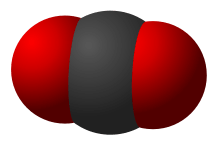Hypocapnia
Hypocapnia or hypocapnea (from the Greek words υπό meaning below normal and καπνός kapnós meaning smoke), also known as hypocarbia, sometimes incorrectly called acapnia, is a state of reduced carbon dioxide in the blood. Hypocapnia usually results from deep or rapid breathing, known as hyperventilation.
| Hypocapnia | |
|---|---|
 | |
| Carbon dioxide |
Hypocapnia is the opposite of hypercapnia.
Effects
Even when marked, hypocapnia is normally well tolerated. Symptoms include tingling sensation (usually in the limbs), abnormal heartbeat, painful muscle cramps, and seizures. Acute hypocapnia causes hypocapnic alkalosis, which causes cerebral vasoconstriction leading to cerebral hypoxia, and this can cause transient dizziness, fainting, and anxiety.[1] A low partial pressure of carbon dioxide in the blood also causes alkalosis (because CO2 is acidic in solution), leading to lowered plasma calcium ions and increased nerve and muscle excitability. This explains the other common symptoms of hyperventilation —pins and needles, muscle cramps and tetany in the extremities, especially hands and feet.
Because the brain stem regulates breathing by monitoring the level of blood CO2 instead of O2, hypocapnia can suppress breathing to the point of blackout from cerebral hypoxia, as exhibited in shallow water blackout.
Hypocapnia also results in bronchoconstriction[1] in order to decrease ventilation. This mechanism is meant to counteract hyperventilation, and decrease the amount of oxygen coming into the lungs. The body's "goal" is to have a relatively even ratio of the partial pressure of oxygen to the partial pressure of carbon dioxide. Chemoreceptors in the body sense a change in partial pressures and pH (hydrogen ion concentration) in the blood. Chemoreceptors are responsible for signaling vasoconstriction, vasodilation, bronchoconstriction, and bronchodilation.
Causes
The main physiologic causes of hypocapnia are related to hyperventilation. Hypocapnia is sometimes induced in the treatment of medical emergencies such as intracranial hypertension[1] and hyperkalaemia.
Self-induced hypocapnia through hyperventilation is the basis for the dangerous schoolyard fainting game. Deliberate hyperventilation has been used by underwater breath-hold divers for the purpose of extending dive time as it effectively reduces respiratory drive due to low CO
2 levels allowing one to break one's standard limit of breath holding at the risk of shallow water blackout (which is a significant cause of drowning) as while air hunger is reduced the oxygen levels are not increased, in fact hypocapnia reduces the oxygen levels available to the brain due to the elevated affinity of oxygen to hemoglobin (Bohr effect) hence highly increasing the chances of blackout.
See also
- Hypercapnia – Abnormally high tissue carbon dioxide levels, increased level of carbon dioxide
- Hyperventilation syndrome, which is often associated with hypocapnia
- Freediving blackout – Loss of consciousness caused by cerebral hypoxia towards the end of a breath-hold dive, where hyperventilation and the subsequent hypocapnia is a cause
References
- Laffey JG, Kavanagh BP (2002). "Hypocapnia". N. Engl. J. Med. 347 (1): 43–53. doi:10.1056/NEJMra012457. PMID 12097540.
External links
| Classification |
|
|---|
Medical examination and history taking | |||||||
| Auscultation | |||||||
| Breathing |
| ||||||
| Other | |||||||
Underwater diving | |||||||||||||||||||||||||||||||
|---|---|---|---|---|---|---|---|---|---|---|---|---|---|---|---|---|---|---|---|---|---|---|---|---|---|---|---|---|---|---|---|
| |||||||||||||||||||||||||||||||
| |||||||||||||||||||||||||||||||
| |||||||||||||||||||||||||||||||
| |||||||||||||||||||||||||||||||
| |||||||||||||||||||||||||||||||
| |||||||||||||||||||||||||||||||
| |||||||||||||||||||||||||||||||
| |||||||||||||||||||||||||||||||
| |||||||||||||||||||||||||||||||
| |||||||||||||||||||||||||||||||
| |||||||||||||||||||||||||||||||
| |||||||||||||||||||||||||||||||
| |||||||||||||||||||||||||||||||
| |||||||||||||||||||||||||||||||
| |||||||||||||||||||||||||||||||
| |||||||||||||||||||||||||||||||
| |||||||||||||||||||||||||||||||
| |||||||||||||||||||||||||||||||